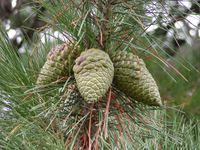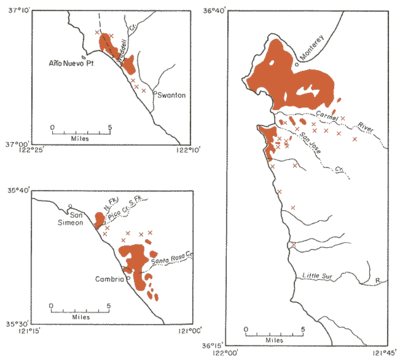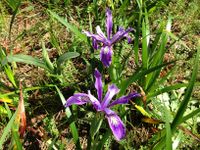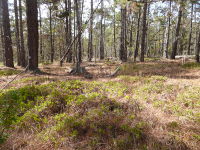Difference between revisions of "Monterey Pine Forest"
From CCoWS Wiki
(→Laws, policies, and regulations) |
(→Laws, policies, and regulations) |
||
| Line 36: | Line 36: | ||
Monterey pine forest is also recognized by State Agencies and Organizations | Monterey pine forest is also recognized by State Agencies and Organizations | ||
| − | *California Department of Fish & Wildlife: Monterey pine forest is listed as a critically imperiled (S1) community by the [[California Natural Diversity Database]].<ref>https://map.dfg.ca.gov/rarefind/view/RF_FieldDescriptions.htm</ref> | + | *[[California Department of Fish & Wildlife (CDFW)]]: Monterey pine forest is listed as a critically imperiled (S1) community by the [[California Natural Diversity Database]].<ref>https://map.dfg.ca.gov/rarefind/view/RF_FieldDescriptions.htm</ref> |
*[[California Native Plant Society]]: Monterey pines are categorized as a 1B.1 plant (rare, threatened, or endangered in California and elsewhere).<ref>http://www.rareplants.cnps.org/glossary.html</ref> | *[[California Native Plant Society]]: Monterey pines are categorized as a 1B.1 plant (rare, threatened, or endangered in California and elsewhere).<ref>http://www.rareplants.cnps.org/glossary.html</ref> | ||
| − | *California Coastal Commission | + | *[[California Coastal Commission]]: Monterey pine forest is identified as sensitive habitat in seven Land Use Plans. Large, contiguous stands of Monterey pine that support special status species meet the definition of Environmentally Sensitive Habitat (ESHA) under the Coastal Act.<ref>Monterey County Local Coastal Program Major Amendment Number 1-05 (Measure A)https://documents.coastal.ca.gov/reports/2006/3/Th8b-3-2006.pdf |
==Central Coast Context== | ==Central Coast Context== | ||
Revision as of 16:51, 1 April 2019
A organizational summary, by the ENVS 560/L Watershed Systems class at CSUMB.
Contents
Monterey pine forest description
- Monterey pine (Pinus radiata) is native to closed-cone coniferous forest within three distinct coastal areas in Central California. The Monterey pine is an evergreen conifer growing to heighs between 15 and 30 meters, with needles mostly 8-15 centimeters long and generally in bundles of three[1]. It's cones are asymmetrical, remain attached to branches for years and often open in response to fire or high temperatures
- Monterey pine forest occurs within low elevations that are subject to marine climate influences and common are associated with sediments of marine origin. Soils in Monterey pine forest are often acidic with a distinct clay layer[2]
Locations of interest
- Monterey pines are limited in occurrence. They are known from Monterey County (Monterey Peninsula), Santa Cruz/San Mateo County (Ano Nuevo) and San Luis Obispo County (Cambria).
- Monterey pines are also known from two island populations off the coast of Baja California, Mexico: Isla Cedros and Isla Guadelupe[3]
Resources at stake
Current protection plans
Laws, policies, and regulations
Monterey pines are identified in several local ordinances in Monterey County:
- City of Carmel by the Sea: City code emphasizes protection of Monterey pine forest and Monterey pine trees. Removal of a Monterey pine requires a permit.
- City of Pacific Grove
- City of Monterey
- Monterey County
Monterey pine forest is also recognized by State Agencies and Organizations
- California Department of Fish & Wildlife (CDFW): Monterey pine forest is listed as a critically imperiled (S1) community by the California Natural Diversity Database.[4]
- California Native Plant Society: Monterey pines are categorized as a 1B.1 plant (rare, threatened, or endangered in California and elsewhere).[5]
- California Coastal Commission: Monterey pine forest is identified as sensitive habitat in seven Land Use Plans. Large, contiguous stands of Monterey pine that support special status species meet the definition of Environmentally Sensitive Habitat (ESHA) under the Coastal Act.[6]
Cite error: <ref> tags exist, but no <references/> tag was found



